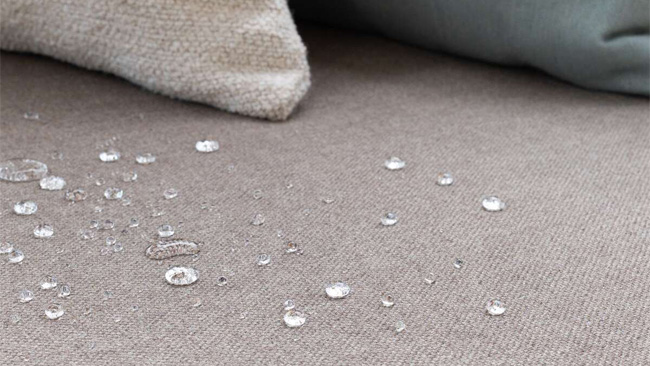There may not seem like there’s a big difference between water-resistant and waterproof materials. However, each has different applications and levels of effectiveness. Whether it's for outdoor seating, awnings, or boat covers, making the right selection for your next outdoor project can have a huge impact on the durability and overall functionality of your fabrics.
Below, we’ll explain what makes these fabrics different, and how to make the right choice for your next project.
Defining Water-Resistance and Waterproofing
Water-resistance: These fabrics are designed to repel water. While there are many ways to achieve this level of resistance, the most common methods usually include fabrics with a tight weave or special coating. Water-resistant materials can protect against splashes and spills, while also providing some protection against rain and water droplets.
Waterproof: If a fabric is waterproof, it means it offers a 100% protective barrier. These kinds of materials are usually enhanced with waterproof coatings or made from waterproof substances, which help them handle prolonged and heavy exposure to downpours, big splashes, waves, and more.
Measuring Waterproof vs. Water Resistant
Manufacturers and third party testers can measure the level of protection offered using certain tests. For example, the hydrostatic head test gauges the amount of water pressure a fabric can withstand before it fails (i.e., leaks). Generally, the higher the water-protection rating, the better it is at resisting water damage.
If you’re in search of the fabrics with the highest resistance levels, one of the best materials includes solution-dyed acrylics, which are offered in the Sunbrella fabric line.
Pros and Cons of Water-Resistant Fabrics
These materials can be great for certain applications, and not so great for others. Before buying a water-resistant fabric, you should keep the following benefits and drawbacks in mind:
Pros:
- More breathable than 100% waterproof options
- Best for light to moderate protection needs (i.e., upholstery)
Cons:
- If exposed to heavy or prolonged rain, it could become saturated
- Most likely won’t endure harsh or long-term wet conditions
Pros and Cons of Waterproof Fabrics
There are many benefits to using waterproof fabric for your next project. However, there are also a few disadvantages you should also be aware of:
Pros:
- Maximum protection against water, even in the most extreme conditions
- Usually best for heavy-duty applications (i.e., marine enclosures, tent fabric, and canopies)
- Incredibly durable and weather resistant
Cons:
- Not as breathable as water-resistant fabrics, which can lead to excessive condensation
When to Use Each Type of Fabric
Your project may require use of waterproof, waterproof fabrics, or both. However, each has specific use-cases.
Water-Resistant Fabrics
Water-resistant fabrics are ideal for shaded areas that aren’t likely to be exposed to direct water — for example, a light mist or occasional splashes of water. That can include your everyday upholstery, casual covers, etc. Some of the best fabrics that offer water-resistant properties include:
- Acrylic
- Polyester
- Nylon
- Waxed Cotton
- Microfiber
Waterproof Fabrics
Waterproof fabrics are ideal for areas that are likely to face heavy water exposure. This may include bimini tops and other types of enclosures that require some form of all-weather protection. A few of the best waterproof products include:
- Marine Vinyl
- Vinyl Laminate
- Vinyl Coated
The Basics of Care and Maintenance
If you want to keep your enclosures, drapery, fixtures, and furniture covers in pristine condition, you’ll need to clean them regularly. In most cases, this only requires you to use mild soap and a bit of water.
If it’s particularly dirty or hasn’t been cleaned in a while, you may want to use a more powerful solution like Sunbrella Clean, 303 Fabric Guard, or IMAR Stamoid Marine Vinyl Cleaner. Otherwise, we’d advise against using harsh chemicals that will destroy or at least diminish the effectiveness of your materials. Learn basic care for both fabrics below.
- Caring For Your Water-Resistant Fabrics: These fabrics are produced with a durable water-repellent (DWR) coating that turns water into beads and helps it easily roll off the surface. If you want these fabrics to remain effective, regularly applying the appropriate water-repellent treatment will help.
- Taking Care of Your Waterproof Fabrics: Though the waterproof membrane stops any water from seeping through, if you want these to outlast the warranty, it’s best to ensure they are properly ventilated. Doing so will help you prevent mildew and mold from growing on the fabric.
Additional Care Tips:
- Follow manufacturer instructions when washing your materials.
- Unless absolutely necessary, don’t expose your fabrics to extreme heat or cold.
- Store fabrics in a cool, dry place.
- Check fabrics regularly for signs of wear. If you do find any damages, repair them as quickly as possible.
Making the Right Choice for Your Needs
Deciding between water-resistant and waterproof fabrics requires you to consider the level of water exposure, desired breathability, and your budget. At Trivantage, we offer a wide variety of high-quality fabrics that cater to all needs.
Whether you’re looking for mildew-resistant marine canvas for your boat covers, awnings, or outdoor furniture, we’ve got you covered. Check out our extensive fabric collection today.




